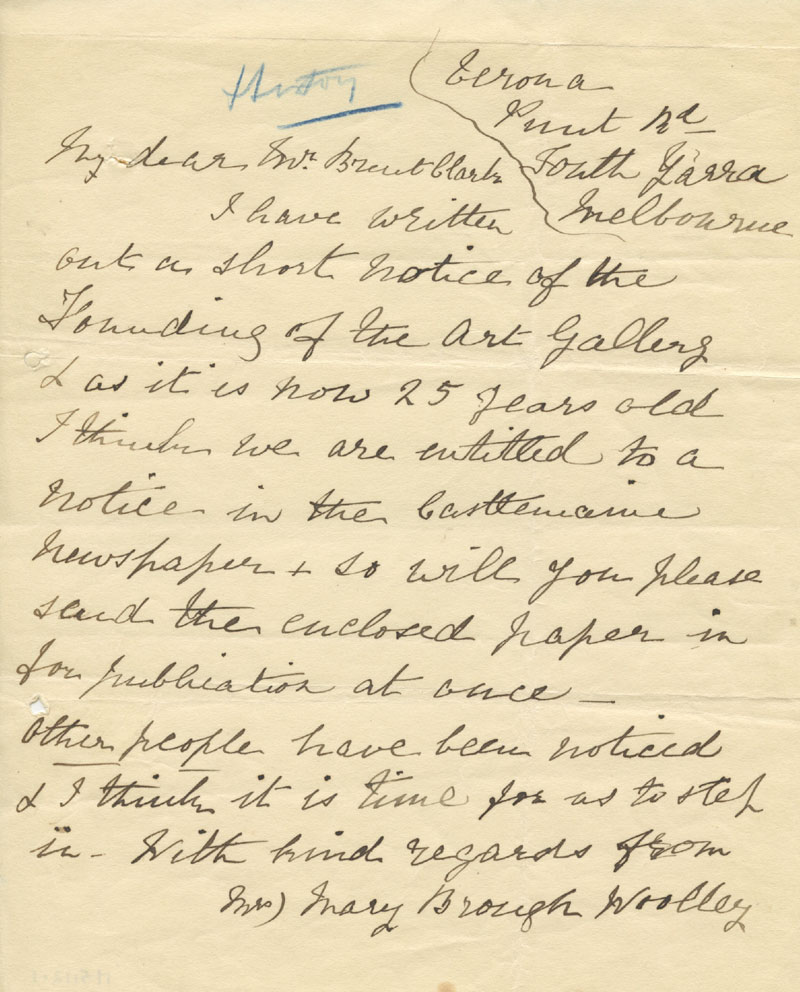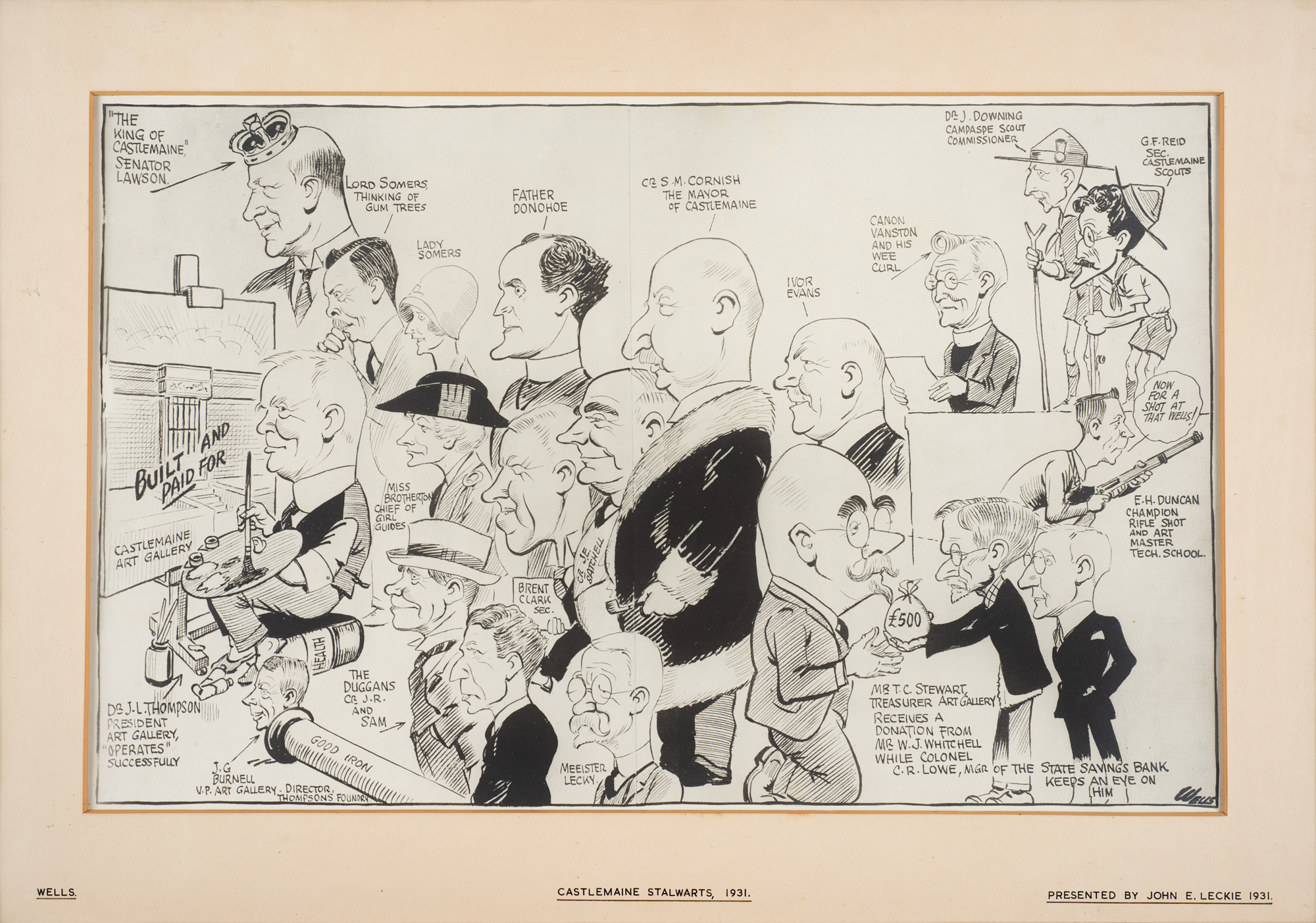Theobald on Miss Brotherton
Local historian Marjorie Theobald reflects on the life of the remarkable Miss Brotherton, one of a small group of local women who imagined and then worked towards establishing an art gallery and museum for Castlemaine.

Theobald on Miss Brotherton
Anna Mary Winnifred Brotherton (“Winnie” to her close friends) was born in Castlemaine in 1875 to Henry and Jane (née Grocott) Brotherton. She was a founding member of the art gallery and intimately involved in all aspects of its administration until her death in 1956.


In 1913 a small group of women—among them Miss Brotherton, Mary Brough Woolley, the artists Alice Newell and Elsie Barlow, and Mrs Bertha Leviny and her daughters—established the gallery in a room lent by Mrs Leviny, probably on the corner of Barker and Lyttleton Streets where the bank now stands. Following a public meeting at the Castlemaine Town Hall in the same year, men became the public face of the movement as was customary in those days, but the gallery as we know it today would never have existed without the determination and hard work of the women.
When the Herald sent its cartoonist SG Wells to capture the opening of the new gallery in 1931, he sketched about twenty men and one woman, Miss Brotherton, though she is included as the Commissioner of Girl Guides rather than as a founder of the gallery.

When her parents died, Miss Brotherton inherited the family home, “Woodlands”, in the haute bourgeois precinct of Burnett Road north of the Botanical Gardens. She evidently inherited sufficient wealth to remain single and live a life of leisure, if not of idleness. In the 1920s she and her niece Nan Cherry (a Bachelor of Arts and a qualified teacher) ran a boarding school for children of special needs, described in an extensive prospectus as run on rural, family and one-on-one principles. The school closed when, in a shocking accident, one of the pupils burned to death. No coroner’s inquest has come to light, but Miss Brotherton closed the house with all its furnishing and move to “Avonsleigh” across Barkers Creek on the Midland Highway, where she remained until her death.
In the last decade of her life, Miss Brotherton fought one last battle—to save the Market building in Mostyn Street from demolition. The affair began in 1946 when the State Electricity Commission made a successful offer to the council to buy the market building site for its central Victorian headquarters, the mayor describing the market as ‘an architectural monstrosity’ worthy only of demolition. Miss Brotherton orchestrated the campaign in Castlemaine, while her close friend, artist AME (Alice) Bale, took the cause to a wider audience in Melbourne. In 1952 a referendum was held, in which a majority of ratepayers voted to save the market, though Miss Brotherton did not live to see the restoration of the building by the National Trust, the State Government and the people of Castlemaine.
Winnie Brotherton was a true eccentric. Those of us who were children in the 1950s remember her gaunt upright figure, dressed in a man’s gabardine coat and a man’s hat, walking along the road from the town centre to her home in Burnett Road. As girl guides, we had to visit her at home to be examined for various badges, and witnessed at first hand the glorious disarray into which “Avonsleigh” had fallen. But still there was her cultured voice, her presence and the dignity that comes with a life well lived in the way of her own choosing.
Marjorie Theobald
September 2020
n 1913 a small group of women—among them Miss Brotherton, Mary Brough Woolley, the artists Alice Newell and Elsie Barlow, and Mrs Bertha Leviny and her daughters—established the gallery in a room lent by Mrs Leviny, probably on the corner of Barker and Lyttleton Streets where the bank now stands. Following a public meeting at the Castlemaine Town Hall in the same year, men became the public face of the movement as was customary in those days, but the gallery as we know it today would never have existed without the determination and hard work of the women. When the Herald sent its cartoonist SG Wells to capture the opening of the new gallery in 1931, he sketched about twenty men and one woman, Miss Brotherton, though she is included as the Commissioner of Girl Guides rather than as a founder of the gallery.
ocal historian Marjorie Theobald reflects on the life of the remarkable Miss Brotherton, one of a small group of local women who imagined and then worked towards establishing an art gallery and museum for Castlemaine.
Theobald on Miss BrothertonAnna Mary Winnifred Brotherton (“Winnie” to her close friends) was born in Castlemaine in 1875 to Henry and Jane (née Grocott) Brotherton. She was a founding member of the art gallery and intimately involved in all aspects of its administration until her death in 1956.
ocal historian Marjorie Theobald reflects on the life of the remarkable Miss Brotherton, one of a small group of local women who imagined and then worked towards establishing an art gallery and museum for Castlemaine.
Theobald on Miss BrothertonAnna Mary Winnifred Brotherton (“Winnie” to her close friends) was born in Castlemaine in 1875 to Henry and Jane (née Grocott) Brotherton. She was a founding member of the art gallery and intimately involved in all aspects of its administration until her death in 1956.
ocal historian Marjorie Theobald reflects on the life of the remarkable Miss Brotherton, one of a small group of local women who imagined and then worked towards establishing an art gallery and museum for Castlemaine.
Theobald on Miss BrothertonAnna Mary Winnifred Brotherton (“Winnie” to her close friends) was born in Castlemaine in 1875 to Henry and Jane (née Grocott) Brotherton. She was a founding member of the art gallery and intimately involved in all aspects of its administration until her death in 1956.
Local historian Marjorie Theobald reflects on the life of the remarkable Miss Brotherton, one of a small group of local women who imagined and then worked towards establishing an art gallery and museum for Castlemaine.
Theobald on Miss BrothertonAnna Mary Winnifred Brotherton (“Winnie” to her close friends) was born in Castlemaine in 1875 to Henry and Jane (née Grocott) Brotherton. She was a founding member of the art gallery and intimately involved in all aspects of its administration until her death in 1956